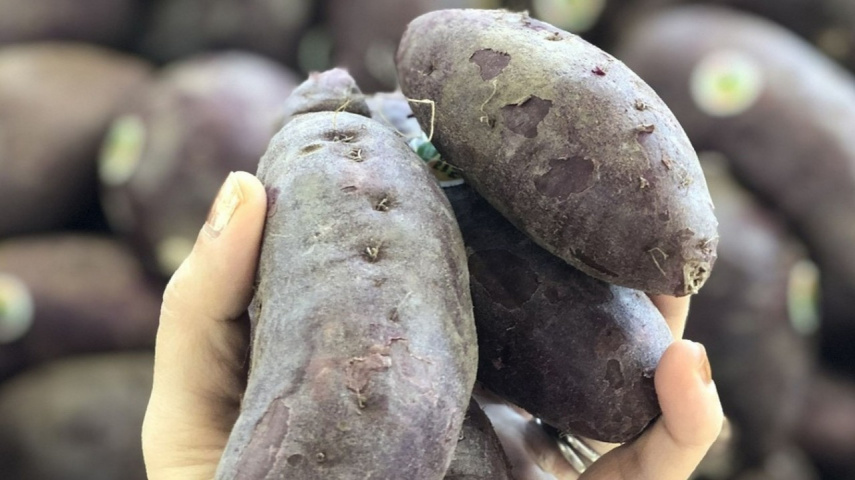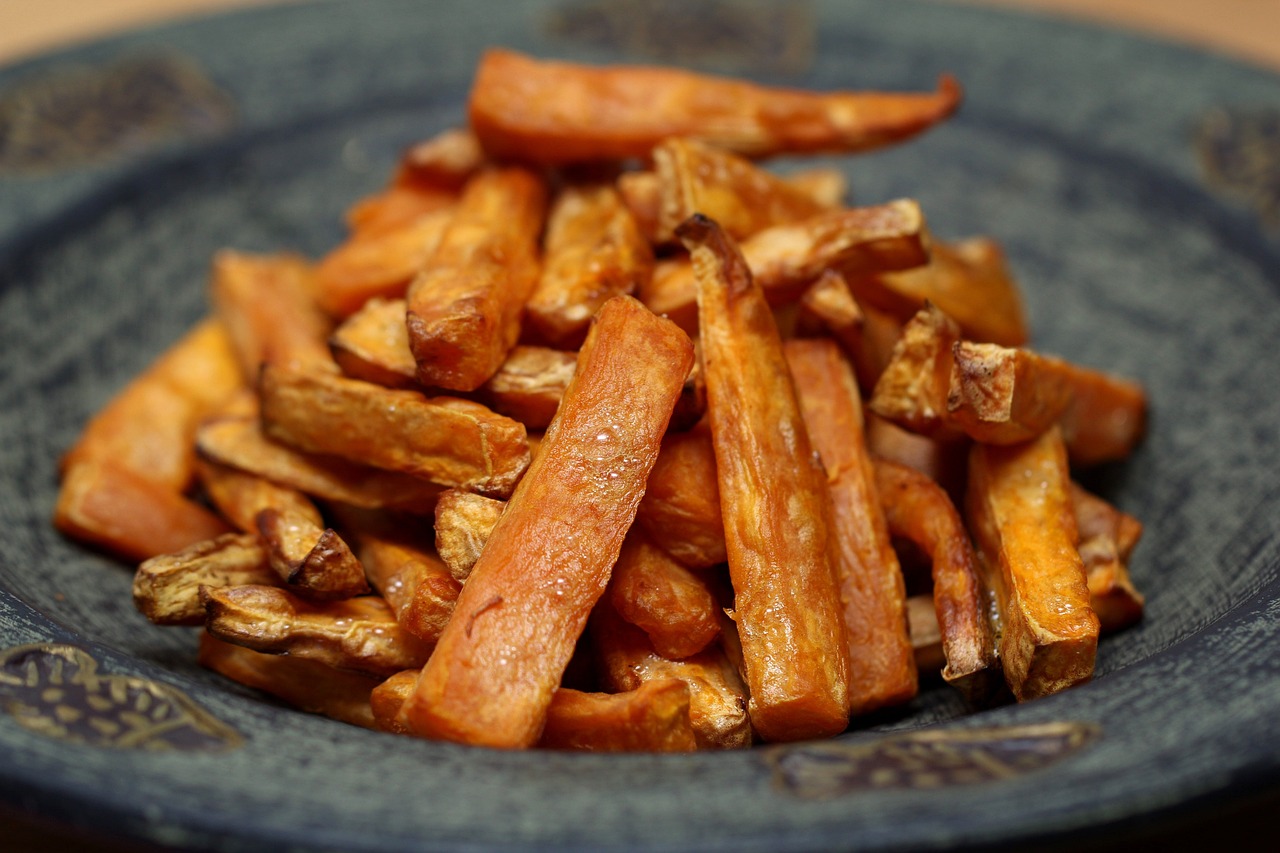Explore the Benefits of Yams and Supercharge Your Diet
There are many benefits of yams that will convince you to add this superfood to your diet. From supporting your digestion to boosting immunity, they do it all!

Let’s settle something first. No, yams are not sweet potatoes. The nutritional value, taste, texture, appearance, and benefits of yams are completely different from the other.
Our contributor Dr. Allen Conrad, Doctor of Chiropractic at Montgomery County Chiropractic Center, says, “A yam is a tuber, which tends to be firmer and a drier texture. A sweet potato may be a bit softer, and it is from the root family of starches. Both have their benefits and offer good nutritional value when consumed in moderation.”
Native to Africa and Asia, yams are starchy root vegetables with rough bark-like skin, whereas, on the inside, they have a starchy and dry texture with a slightly sweet and earthy flavor. They are a good source of complex carbohydrates, dietary fiber, vitamin C, potassium, and manganese (1). Owing to their nutritional profile, yams offer many health benefits such as aiding digestion, regulating blood sugar levels, providing antioxidants, and having anti-inflammatory properties (2). We will learn all about it today in this article.
What are Yams and Their Types?
The yam vegetable is an important food source in many parts of the world, particularly in West Africa. They come in a range of colors extending from brown to black. Even the color of their flesh changes from one another. Depending on the variety, they are typically white, yellow, or purple, depending on the variety. Yams have a firm and starchy texture when raw, but they become soft and creamy when cooked. What’s more is that they are delicious and can be used in a variety of dishes, including stews, soups, curries, and side dishes. They can be baked, boiled, roasted, fried, or mashed, making them a versatile ingredient in the culinary world.
There are several types of yams, each with its own unique characteristics. Here are some common types of yams:
- White Yam (Dioscorea rotundata): This is one of the most widely cultivated yam varieties. It has rough, brown, or black skin and white flesh. White yams are known for their firm texture and starchy taste. Also, there are many white yam benefits like improving bone health and decreasing cholesterol levels (3).
- Yellow Yam (Dioscorea cayenensis): Also known as "Kwadu" or "Water Yam," this type of yam has rough, brown, or black skin and yellow flesh. It is softer and less starchy compared to white yams.
- Chinese Yam (Dioscorea polystachya): Chinese yam, also called "Nagaimo" or "Shan Yao," is a popular variety in East Asia. It has light brown, hairy skin and crisp, juicy flesh. Chinese yams have a slightly sweet and nutty flavor.
- Cush-cush Yam (Dioscorea trifida): Cush-cush yams have rough, reddish-brown skin and creamy, white, or yellow flesh. They are native to the Caribbean and have a sweet and moist texture when cooked.
- Purple Yam (Dioscorea alata): Also known as "Ube" in the Philippines, purple yams have vibrant purple or lavender skin and deep purple flesh. They have a sweet and nutty flavor and are commonly used in desserts and sweet dishes.
- Winged Yam (Dioscorea alata): Winged yams have rough, brown, or reddish skin with distinctive wing-like ridges. The flesh is typically white or yellow and has a mild, slightly sweet taste.
- Lesser Yam (Dioscorea esculenta): This is a very widely-loved vegetable in Southern Vietnam and India. It features brown outer skin with white or pale yellow flesh. They are also known as Chinese Yam and have a mild flavor.
- Japanese Mountain Yam (Dioscorea Japonica): Also known as East Asian mountain yam or yamaimo, these are native to Assam, Taiwan, Korea, China, and India. The exterior skin resembles a potato and the inner flesh has a bright white silky sticky texture. Furthermore, it has a lightly sweet flavor.
Bella Carvosso says, “Determining the "healthiest" type of yam can depend on individual dietary needs and preferences. However, in terms of nutritional content, many consider the white-fleshed yam, also known as the Dioscorea rotundata or "white yam," to be a nutritious choice. It offers a good source of carbohydrates, fiber, vitamins (such as vitamin C and B-complex vitamins), and minerals like potassium and manganese”.
Nutritional Value of Yams
Yams are a nutrient-rich vegetable and provide several important vitamins, minerals, and dietary fiber (1).. Hence, there are many health benefits of yams. The specific nutritional composition may vary slightly depending on the variety and cooking method, but here is a general overview of the nutritional value of yams per 100 grams of raw yam (4):
- Calories: Approximately 118 calories
- Carbohydrates: Around 27 grams, consisting mainly of complex carbohydrates, including starch and dietary fiber
- Fiber: Roughly 4 grams of dietary fiber, which helps support digestive health and can contribute to feelings of fullness
- Protein: About 1.5 grams of protein, although the protein content in yams is relatively low compared to other food sources
- Fat: Yams are low in fat, typically containing less than 0.2 grams
- Vitamins: The vitamins in yams include vitamin C, vitamin B6, and vitamin A (as beta-carotene). The vitamin C content contributes to immune function and collagen synthesis, while vitamin B6 is involved in metabolism and brain development. Beta-carotene, converted to vitamin A in the body, supports vision and skin health
- Minerals: Yams are rich in potassium, providing around 816 milligrams per 100 grams. Potassium is essential for maintaining proper heart function and supporting healthy blood pressure. Yams also contain other minerals such as manganese, copper, and magnesium in smaller amounts
It is essential to note that every food item’s nutritional value can differ based on many factors like variety, ripeness, and cooking methods. If you are a health-conscious person, then try to steam or bake your yams to retain their nutritional value rather than frying them.
Health Benefits of Yams
If you don’t know what are yams good for, then you will be surprised to know the several benefits of yams as they have a rich nutrient content and unique compounds. Here are some potential health benefits associated with yams:
1. Improves Gut Health
Yams are a good source of dietary fiber, both soluble and insoluble. Fiber adds bulk to the stool and helps promote regular bowel movements, preventing constipation(2). Adequate fiber intake can also contribute to a healthy gut microbiome by providing nourishment for beneficial bacteria in the intestines. Not just that but the fiber in yams acts as a prebiotic, which means it serves as food for beneficial bacteria in the gut.
This promotes a healthy balance of gut microbiota, which can contribute to improved digestion, nutrient absorption, and overall gut health (5). In addition to that, yam vegetables have a high water content, which can help soften the stool and ease the passage through the digestive tract. And again, if you want to promote proper digestion and prevent problems like constipation, you will need to stay hydrated and eat good foods like yam and sweet potatoes.
2. May Alleviate Menopause Symptoms
One of the main health benefits of yam is that it may significantly reduce the symptoms of menopause, particularly the variety called Dioscorea villosa or wild yam. They have been traditionally used as a natural remedy for menopausal symptoms. Wild yam contains a substance called diosgenin, which is a precursor to the hormone progesterone.
Some people believe that consuming or using wild yam products can help alleviate menopausal symptoms by providing a source of progesterone (6). In addition to that, it also helps diminish pelvic cramps and problems associated with the menstrual cycle and childbirth.
3. May Fight Cancer-causing Enemies
Are yams healthy? Yes. Like many other fruits and vegetables, yams are extremely healthy and contain various compounds that have the potential to exhibit anti-cancer properties. These compounds include antioxidants, phytochemicals, and dietary fiber, which collectively contribute to the potential cancer-fighting effects (7).
Furthermore, yams consist of various phytochemicals, such as polyphenols and flavonoids, which are known for their potential anti-cancer properties. These compounds have been associated with reducing inflammation, inhibiting the growth of cancer cells, and promoting apoptosis (programmed cell death) in cancer cells (8). Therefore, adding yams to your diet is a great idea if you want to stay away from cancer-causing agents.
4. Reduces Inflammation
All types of yams contain antioxidants, such as vitamin C and various phytochemicals, which can help neutralize free radicals and reduce oxidative stress (9). When you consume yams, you are automatically reducing oxidative stress, which helps alleviate inflammation.
Also, they contain phytochemicals like diosgenin, which is known for its potential anti-inflammatory effects. Additionally, these compounds have been known for their ability to inhibit inflammatory pathways and modulate the production of inflammatory markers in the body (10).
5. Has Antioxidant Properties
One of the benefits of eating yams is that they possess antioxidant properties due to the presence of various compounds like vitamins and phytochemicals. To note, vitamin C is an antioxidant agent that helps neutralize harmful free radicals in the body, reducing oxidative stress and protecting cells from damage themselves. By scavenging free radicals, vitamin C supports overall health and plays a role in reducing the risk of chronic diseases (11).
Yams, especially those with orange or purple flesh, are rich in beta-carotene, a predecessor to vitamin A. This beta-carotene acts as an antioxidant and is converted to vitamin A in the body. Vitamin A also functions as an antioxidant, protecting cells from damage caused by free radicals. And lastly, you will be surprised to learn this fun fact — the phytochemicals present in root vegetables contribute to the vibrant colors of some yams, such as the purple-fleshed varieties (12).
6. May Promote Skin Health
With the presence of antioxidants like vitamin C, beta-carotene, and other phytochemicals, yams help in protecting the skin from oxidative stress caused by free radicals, which can lead to premature aging and damage to the skin cells. When you neutralize radicals by consuming yams, it can contribute to having healthy and youthful-looking skin (9).
Along with that, vitamin C also plays a vital role in collagen synthesis. Collagen is a protein that provides structure and elasticity to the skin. When you consume adequate vitamin C, it supports the production of collagen, which helps in maintaining your skin’s elasticity, firmness, and provides a more radiant and glowing appearance (13).
7. Promotes Heart Health
Yams play a significant role in promoting cardiovascular health as they are a good source of potassium, a mineral that is known to maintain heart health. Potassium helps regulate blood pressure by counteracting the effects of sodium and promoting vasodilation, which helps relax and widen blood vessels. Adequate potassium intake is associated with lower blood pressure levels, therefore reducing the risk of cardiovascular diseases (14).
Additionally, yams are good for you as they contain dietary fiber, including both soluble and insoluble types. Fiber is beneficial for heart health as it helps regulate cholesterol levels. Soluble fiber can help lower LDL (bad) cholesterol levels by binding to cholesterol in the digestive system and reducing its absorption. By maintaining healthy cholesterol levels, yams support heart health and reduce the risk of cardiovascular diseases (15).
8. May Aid in Weight Loss
Are yams good for weight loss? Since they are relatively low in calories compared to other starchy foods, such as potatoes or rice. This means you can enjoy a satisfying portion of yams while keeping your overall calorie intake in check. However, it's important to keep portion sizes in mind and consider the overall balance of your diet. While yams can be part of a weight loss plan, it's essential to incorporate a variety of foods, maintain a calorie deficit, and consider your individual nutritional needs.
Also, yams are a source of complex carbohydrates, which are digested more slowly than simple carbohydrates. This slower digestion provides a steady release of energy that may help prevent rapid spikes and drops in blood sugar levels, keeping you satisfied and reducing cravings.
9. May Boost Fertility
Wild yam contains a compound called diosgenin, which is a precursor to the hormone progesterone. It’s important to note that hormonal treatments derived from wild yams have been developed, by extraction and synthesis of specific compounds rather than direct consumption of yams.
10. Strengthens the immune system
Yams contain other essential nutrients, such as vitamins A and E, as well as minerals like manganese and copper. These nutrients play important roles in supporting immune function and maintaining overall health. As mentioned earlier, the presence of vitamin C has the ability to produce white blood cells, which are crucial for fighting off infections and diseases.
It’s not necessary that all these benefits of yams will cater to every human being. Responses may vary from one person to another. If you have made up your mind to add this tasty vegetable to your meal plan, let’s quickly take a look at some recipes you can make.
How to Eat Yams
Yams can be baked, roasted, fried, and steamed. You can add them to your dessert, curries, and salads. Take a look at some of the easiest recipes that you can try at home:
1. Roasted yams
Let’s start with the easiest yam recipe ever. Here are the steps:
- Preheat the oven to 425°F (220°C).
- Peel and cube yams into bite-sized pieces.
- Toss the yam cubes with olive oil, salt, pepper, and your choice of spices, such as paprika, garlic powder, or rosemary.
- Spread the seasoned yam cubes on a baking sheet in a single layer.
- Roast for 25-30 minutes, or until the yams are tender and golden brown.
- Serve as a side dish, snack, or you can also top it on salads.2
2.Yam and black bean chili
For jjajangmyeon lovers, this yam and black bean chili will leave you in a food coma. The steps include:
- Heat olive oil in a large pot over medium heat.
- Add chopped onions, minced garlic, and diced yams. Sauté for a few minutes until the onions are translucent.
- Stir in chili powder, cumin, paprika, salt, and pepper to taste.
- Add canned diced tomatoes, drained and rinsed black beans, vegetable broth, and a bay leaf.
- Bring the mixture to a boil, then reduce the heat and simmer for about 20-25 minutes, or until the yams are tender.
- Remove the bay leaf before serving. Garnish with chopped cilantro or sliced green onions, if desired.
3. Yam and coconut curry
Curry lovers, we got your back! Here is a lip-smacking dish for you to try:
- Heat oil in a large pan over medium heat. Add diced onions, minced garlic, and grated ginger. Sauté until onions are soft.
- Stir in curry powder, cumin, turmeric, coriander, and red chili flakes (adjust the spice level to taste).
- Add diced yams, chopped tomatoes, and coconut milk to the pan. Season with salt and pepper.
- Simmer the mixture for about 15-20 minutes until the yams are tender.
- Serve the curry over cooked rice or with naan bread.
4. Baked yam fries

It’s time to ditch the unhealthy French fries and switch over to baked yam fries. Enjoy guilt-free snacking by following the below recipe:
- Preheat the oven to 425°F (220°C).
- Peel yams and cut them into fry-shaped pieces.
- In a bowl, toss the yam fries with olive oil, smoked paprika, garlic powder, salt, and pepper.
- Arrange the seasoned fries on a baking sheet lined with parchment paper.
- Bake for about 20-25 minutes, flipping halfway through, until the fries are crispy and golden brown.
- Serve with your favorite dipping sauce, such as spicy mayo or a yogurt-based dip.
Side Effects of Yams
Yams are safe to eat for everyone including pregnant women. However, wild yams must be avoided during pregnancy and they can be harmful to pregnant women. The rest of them are generally safe to eat. However, just like other edibles, there are side effects to yams as well. Here are a few potential side effects or considerations related to yams:
Allergic Reactions:
Some people may be allergic to yams or other related tuber vegetables. Allergic reactions can range from mild symptoms like itching, hives, or swelling, to more severe reactions like difficulty breathing or anaphylaxis. If you have known allergies to yams or other tubers, it's advisable to avoid consuming them.
Digestive Issues:
Yams are high in dietary fiber, which can promote healthy digestion. However, consuming too much fiber or increasing fiber intake abruptly can cause gastrointestinal discomfort, bloating, gas, or diarrhea in some individuals (16). It's recommended to gradually introduce fiber-rich foods into your diet and drink plenty of water to support proper digestion.
Oxalate Content:
Yams, particularly purple yams, contain oxalates. High oxalate intake can contribute to the formation of kidney stones in susceptible individuals (17). So, if you have a history of kidney stones or have been advised to follow a low-oxalate diet, it's advisable to consume yams in moderation or avoid them altogether.
Interactions with Other Drugs:
Yams, particularly wild yams, contain compounds that can interact with certain medications, including blood-thinning medications and hormonal therapies. If you are taking any medications, it's important to consult with your healthcare professional before incorporating significant amounts of yams or yam supplements into your diet.
Conclusion
Enjoy the deliciousness, nutrition, and benefits of yams without compromising your health. They are a versatile ingredient that can be added to any dish. Plus, they are a good source of dietary fiber, vitamins, such as vitamin C and vitamin A, minerals like potassium and manganese, and antioxidants. Go ahead and include them in your meal plan to give yourself a wholesome eating experience.
Contributor: Dr. Allen Conrad, BS, DC, CSCS, and Owner of Montgomery County Chiropractic Center





 JOIN OUR WHATSAPP CHANNEL
JOIN OUR WHATSAPP CHANNEL
































































































